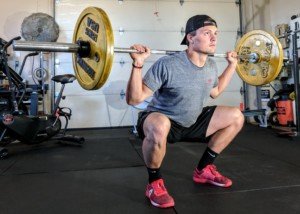
There’s no need for alarm if your quad muscles twitch up a storm after thrashing them with your squat routine.
Though muscle twitching can signal disease in very rare instances, this should be the furthest thing from your mind after you just squatted 225.
“Many people experience an annoying, random or rhythmic twitching of the thigh muscles of the leg called the quadriceps,” points out neurologist Anthony P. Geraci, MD, associate professor of neurology at Donald & Barbara Zucker School of Medicine in New York.
“These twitches (fasciculations), can occur in many muscles throughout the body,” adds Dr. Geraci, “and are particularly noticeable in some people after exercise.”
And if exercise can bring on benign muscle twitches, it stands to reason that the back squat would lead the pack, as this can be a brutal exercise when done intensely and especially past the parallel mark, let alone full ATG.
“The muscle uses glucose and oxygen from the blood as its energy source,” explains Dr. Geraci about exercise such as squats.
“After a certain amount of time, say 20 minutes, the muscle must turn to other sources of energy; its requirements go up, but the fuel of available glucose goes down.”
Glucose is blood sugar, which rises when you eat carbohydrates, and rises quickly when you consume a so-called fast-acting carb like juice.
When the blood sugar goes down, says Dr. Geraci, “this is when the muscle metabolizes fats in the body to use as fuel, leading to a buildup in the cell of lactic acid.”
Certainly you’ve heard of lactic acid, as most muscle-building enthusiasts have.
It’s an unavoidable byproduct of a serious weightlifting workout.

hutterstock/UfaBizPhoto
“As lactic acid builds up in the muscle,” continues Dr. Geraci, “a chain of events takes place that temporarily ‘injures’ the muscle cell and de-stabilizes its cell membrane.”
And that’s the point of lifting weights: to “injure” the cell so that it’s forced to rebuild stronger in anticipation of the next training session.
“Normally, the muscle membrane is kept stable by the single nerve fiber attached to it,” says Dr. Geraci.
“However, if the chemical soup within the muscle is temporarily toxic to the membrane, it sets off an electrical impulse, referred to as depolarization.
“And this is the basic process that leads to muscle fiber contraction.

Shutterstock/BLACKDAY
“During the resting phase after exercise, muscle cleanses itself of the lactic acid and other free-radical metabolites (the bad molecules that de-stabilize the membrane), and within time the twitches subside.”
So now you know why you experience twitching in your quads, maybe hams and glutes after a crushing routine of squats — and these fasciculations may occur a few hours later when you’re finally settled down at rest in front of a computer.
But what if hours and hours after your squats, the muscle twitching persists?
Dr. Geraci explains that this is a “manifestation of a de-stabilized muscle fiber membrane. Each muscle has tens of thousands of muscle fibers, so if a few have unstable membranes that contract and cause a twitch, there will be no consequence [no negative effect] to strength or muscle health.”
Instead, you should just focus on getting under that barbell the next training session and performing your squats as usual, along with your other leg movements such as presses, deadlifts, lunges and extensions.
Muscle twitching during or after squats can also be caused by something you’re drinking before, during or after the training session that contains caffeine.
Dr. Geraci says caffeine can cause these benign fasciculations. Other causes are anxiety and inadequate magnesium.
Be sure you’re getting enough magnesium.
You may want to consider taking supplemental magnesium citrate powder, especially following workouts involving squats.
This mineral helps relax muscles and helps prevent cramping.
Final Thoughts on Muscle Twitching after Squats
“The bottom line is that muscle twitches, particularly in young persons who are exercising, are almost NEVER a sign of a serious neurological condition,” says Dr. Geraci, “just a sign you are using your muscles the way they were meant to be used!”
 Dr. Geraci is also the director of neuromuscular medicine at Northwell Health in New York.
Dr. Geraci is also the director of neuromuscular medicine at Northwell Health in New York.
 Lorra Garrick has been covering medical, fitness and cybersecurity topics for many years, having written thousands of articles for print magazines and websites, including as a ghostwriter. She’s also a former ACE-certified personal trainer.
Lorra Garrick has been covering medical, fitness and cybersecurity topics for many years, having written thousands of articles for print magazines and websites, including as a ghostwriter. She’s also a former ACE-certified personal trainer.
.









































